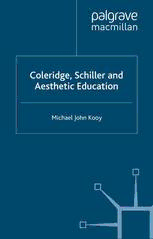
Coleridge, Schiller and Aesthetic Education PDF
Preview Coleridge, Schiller and Aesthetic Education
Coleridge, Schiller and Aesthetic Education This page intentionally left blank Coleridge, Schiller and Aesthetic Education Michael John Kooy © Michael John Kooy, 2002 Softcover reprint of the hardcover 1st edition 2002 978-0-333-74936-4 All rights reserved. No reproduction, copy or transmission of this publication may be made without written permission. No paragraph of this publication may be reproduced, copied or transmitted save with written permission or in accordance with the provisions of the Copyright, Designs and Patents Act 1988, or under the terms of any licence permitting limited copying issued by the Copyright Licensing Agency, 90 Tottenham Court Road, London W1T 4LP. Any person who does any unauthorised act in relation to this publication may be liable to criminal prosecution and civil claims for damages. The author has asserted his right to be identified as the author of this work in accordance with the Copyright, Designs and Patents Act 1988. First published 2002 by PALGRAVE Houndmills, Basingstoke, Hampshire RG21 6XS and 175 Fifth Avenue, New York, N. Y. 10010 Companies and representatives throughout the world PALGRAVE is the new global academic imprint of St. Martin’s Press LLC Scholarly and Reference Division and Palgrave Publishers Ltd (formerly Macmillan Press Ltd). ISBN 978-1-349-41174-0 ISBN 978-0-230-59678-8 (eBook) DOI 10.1057/9780230596788 This book is printed on paper suitable for recycling and made from fully managed and sustained forest sources. A catalogue record for this book is available from the British Library. Library of Congress Cataloging-in-Publication Data Kooy, Michael John, 1969– Coleridge, Schiller, and aesthetic education/Michael John Kooy. p. cm. Includes bibliographical references and index. 1. Coleridge, Samuel Taylor, 1772–1834—Knowledge—Literature. 2. Schiller, Friedrich, 1759–1805—Appreciation—England, 3. Criticism— Great Britain—History—19th century. 4. Coleridge, Samuel Taylor, 1772–1834—Aesthetics. 5. Literature—History and criticism—Theory, etc. 6. Schiller, Friedrich, 1759–1805–Aesthetics. 7. Schiller, Friedrich, 1759–1805—Influence. 8. English poetry—German influences. 9. Aesthetics, Modern—19th century. 10. Aesthetics, Modern–18th century. I. Title. PR4487.L5 K66 2002 821′.7—dc21 2001036986 10 9 8 7 6 5 4 3 2 1 11 10 09 08 07 06 05 04 03 02 Typeset by Integra Software Services Pvt. Ltd., Pondicherry, India www.integra-india.com for Katya This page intentionally left blank Contents Acknowledgements ix List of Abbreviations xi Introduction: Reading Coleridge through Schiller 1 A note on texts and translations 1 Schiller and the Young Coleridge 9 Schiller in the 1790s: Jena and Weimar Coleridge’s reading of Schiller’s early plays Beddoes and the Horae 2 Coleridge and Weimar Classicism 33 Coleridge in Göttingen The aesthetics of Wallenstein 3 British Germanophiles 45 The German Museum Schiller and the British literary press Coleridge’s reading of Schiller’s prose 4 Schiller’s Poetry in Coleridge’s Notebooks 67 Gedichte Part 1: dejection and theological speculation Gedichte Part 2: pantheism, metrics, the ‘beautiful soul’ Coleridge abroad, Schiller abroad The Muses’ Almanac and the new aesthetics Three translations 5 Semblance and Aesthetic Autonomy in Coleridge’s Criticism 95 Coleridge and The Critique of Judgement Autonomy in the Aesthetic Letters ‘Semblance’ in Biographia Literaria 6 Aesthetic Education in Biographia Literaria, The Friend and the Lectures on Literature 115 Aesthetic freedom / moral freedom vii viii Contents Biographia and beyond: Schelling or Schiller? Didacticism 7 Coleridge’s ‘Aesthetic State’ 141 Bildung and politics ‘Cultivation’ and the state 8 The Clerisy and Aesthetic Education 167 Cultivating the nation Women in the ‘Aesthetic State’ Imagined female figures 9 Epilogue: Bildung and History 193 Schiller’s sublime history Coleridge, Bildung and providential history Notes 207 Selected Bibliography 221 Index 231 Acknowledgements This book began as a chapter in my doctoral thesis, which I wrote while at Keble College, Oxford, and it grew into its present shape while I held posts at Corpus Christi College, Oxford, and the University ofWarwick. During this time my work on the subject has been encouraged by many people; to three of them in particular I owe a large debt of gratitude: Roy Park, my thesis supervisor, for his inde- fatigable attention to detail; Elinor Shaffer, for encouraging me not to underestimate the strength of the Coleridge–Schiller relationship; and Michael Bell, whose chapter on Schiller in Sentimentalism, Ethics and the Culture of Feeling (2000) I read just as this book was going to press, for encouraging me to think about the broader issues in Schil- ler’s reception and, not least, for kindly agreeing to read and comment upon a draft of this book. Lesley Sharpe, Joyce Crick and Stephen Gill also read selections ofthe book and I am grateful to them for their careful and discrimin- ating responses. I thank, too, a large number of people whose timely comments helped to shape this book, probably in ways unbe- knownst to them: John Beer, Thomas McFarland, Heather Jackson, Peter Larkin, Anya Taylor, Raimonda Modiano, Nick Halmi, Graham Davidson, Douglas Hedley, Lucy Newlyn, Geoffrey Rowell, Val Cunningham, Christine Battersby, Andrew Benjamin, F. J. Lamport and Paul Hamilton. The book has also benefited from the intellectual exchange fostered by the postgraduate seminar at Oxford, ‘Romantic Realign- ments’, and in particular by two contemporaries of mine, both Coleridgeans: Tim Milnes and Seamus Perry. Much of the research for this book was carried out at the Taylor Institution Library, Oxford, and I am grateful to the librarians there, especially Giles Barber, Jill Hughes and David Thomas, for their expert advice and for helping to see me through one, rather lean, year. I also owe adebt of gratitude to a colleague at Warwick, Martin Warner, whose work on the relationship between philosophy and literature is a kind of edu- cation in its own right. ix
